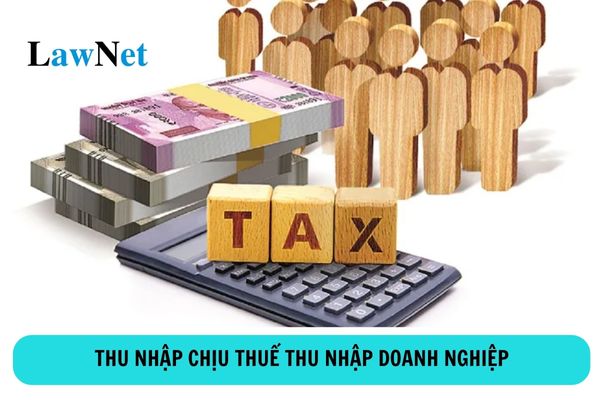What does income subject to CIT in Vietnam include?
What does income subject to CIT in Vietnam include?
Under Article 3 of CIT Law 2008, amended by Clause 1, Article 1 of Law on Amendments to Tax Laws 2014, taxable income includes income from production and business activities in goods and services and other income.
Other income includes:
- income from transfer of capital, transfer of the right to capital contribution;
- income from real estate transfer, transfer of construction projects, transfer of the right to participate in construction projects, transfer of the right to mineral exploration, mineral extraction, and mineral processing;
- income from the right to enjoyment of property, right to ownership of property, including income from intellectual property rights defined by law;
- income from transfer, lease, liquidation of assets, including valuable papers; income from deposit interest, loan interest, sale of foreign exchange;
- income from collection of debts that were cancelled;
- income from receipts from debts without creditors; incomes from business operation in previous years that were committed, and other incomes.
Concerning Vietnamese companies making investments in the countries with which Vietnam has a Double Taxation Agreement and transfers incomes exclusive of CIT paid overseas to Vietnam, regulations of such Double Taxation Agreements shall apply.
If investments are made in countries with which Vietnam has not had Double Taxation Agreements, and if CIT incurred in such countries is lower than that imposed by the Law on CIT of Vietnam, the tax difference shall be paid.

What does income subject to CIT in Vietnam include? (Image from Internet)
What income is exempt from CIT?
According to Article 4 of the Law on CIT 2008 amended and supplemented by clause 3, Article 1 of the Law on Amendment to Law on CIT 2013 and Clause 2, Article 1 of Law on Amendments to Tax Laws 2014, income exempt from CIT includes:
- Income from crop planting, husbandry, aquaculture, processing of agricultural and seafood products, and salt production by cooperatives; income of cooperatives operating in the agriculture, forestry, fishery, and salt industries in areas with difficult socio-economic conditions or in areas with particularly difficult socio-economic conditions; income of enterprises from crop planting, husbandry, aquaculture, processing of agricultural and seafood products in areas with particularly difficult socio-economic conditions; income from seafood catching activities.
- Income from providing direct technical services serving agriculture.
- Income from the implementation of research and development contracts, products in the trial production period, products made from new technology applied for the first time in Vietnam.
- Income from production and business activities of goods and services of enterprises where 30% of the average workforce in a year or more are people with disabilities, people after rehabilitation, people infected with the Human Immunodeficiency Virus (HIV/AIDS) and having an average workforce of twenty or more people in a year, excluding enterprises operating in the finance, real estate business sectors.
- Income from vocational training activities specifically for ethnic minorities, people with disabilities, children in particularly difficult circumstances, and social evils subjects.
- Income allocated from capital contribution activities, joint ventures with domestic enterprises, after paying CIT as prescribed by the Law on CIT 2008.
- Sponsorships received for activities in education, scientific research, culture, arts, charity, humanitarian aid, and other social activities in Vietnam.
- Income from the transfer of emission reduction certificates (CERs) of enterprises granted emission reduction certificates.
- Income from performing State-assigned duties of the Vietnam Development Bank in investment credit, export credit; income from credit activities for the poor and other policy objects of the Social Policy Bank; income of state financial funds and other state funds operating not for profit as prescribed by law; income of organizations wholly owned by the State formed to handle bad debts of Vietnamese credit institutions.
- Undistributed income of socialized establishments in the fields of education, training, healthcare, and other socialized fields to be reinvested in those establishments according to specialized laws on education, training, healthcare, and other socialized fields; income forming non-distributable assets of cooperatives established and operating under the 2023 Law on Cooperatives.
- Income from technology transfer within priority sectors to organizations or individuals in areas with particularly difficult socio-economic conditions.
What is the current CIT rate in Vietnam?
According to Article 10 of the Law on CIT 2008 amended and supplemented by clause 6, Article 1 of the Law on Amendment to Law on CIT 2013 (with phrases replaced by clause 1, Article 67 of the Petroleum Law 2022), the CIT rate is regulated as follows:
Tax rate
1. The CIT rate is 22%, except for cases specified in clauses 2, 3 of this Article and entities eligible for tax rate incentives as prescribed in Article 13 of this Law.
Cases subject to the 22% tax rate as prescribed in this clause shall apply a 20% tax rate from January 01, 2016.
2. Enterprises with total annual revenue not exceeding twenty billion dong apply a tax rate of 20%.
The revenue base for determining enterprises eligible for the 20% tax rate in this clause is the revenue of the previous year.
3. The CIT rate for petroleum operations is from 25% to 50% in accordance with each petroleum contract; the CIT rate for activities of searching, exploring, and exploiting other precious resources in Vietnam is from 32% to 50% in accordance with each project, each business establishment.
The Government of Vietnam shall detail and guide the implementation of this Article.
Thus, the current CIT rate is 20%.
The CIT rate for petroleum operations is from 25% to 50% in accordance with each petroleum contract; the CIT rate for activities of searching, exploring, and exploiting other precious resources in Vietnam is from 32% to 50% in accordance with each project, each business establishment
* For enterprises with total annual revenue not exceeding twenty billion dong, the tax rate is 20%.

